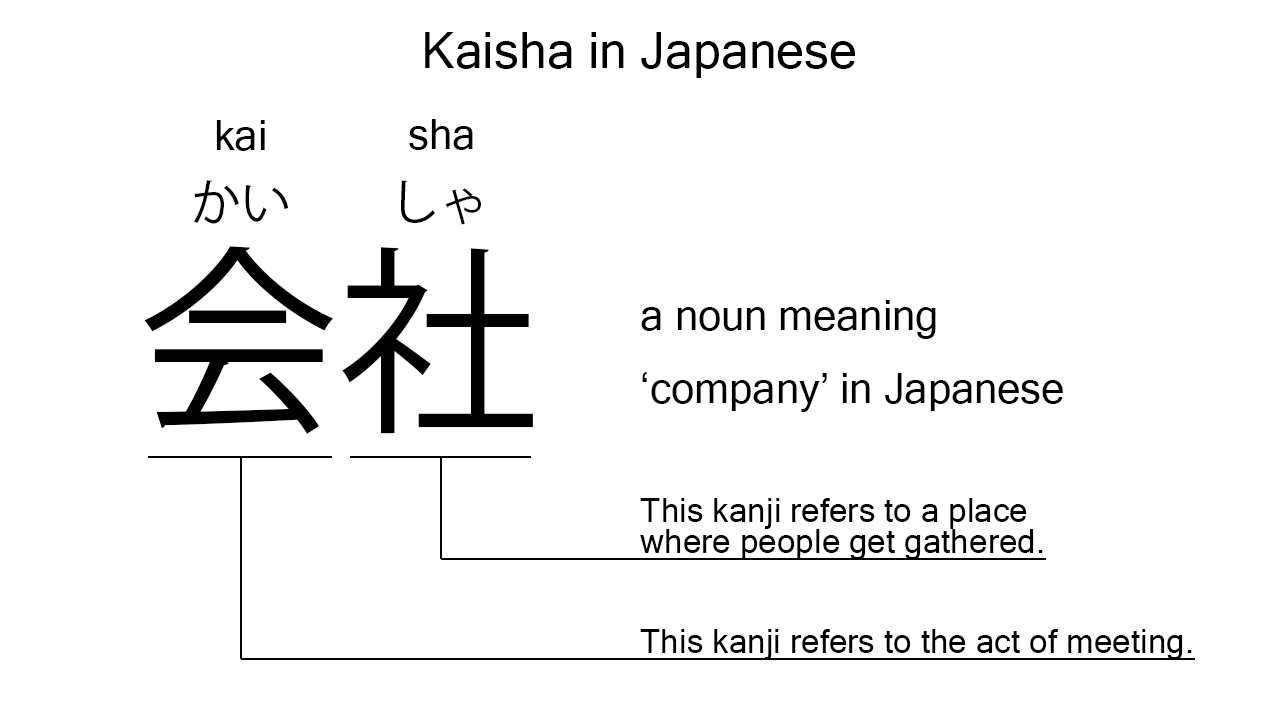What does “kaisha” mean in Japanese?
Native speakers use kaisha often to mean a ‘company’ in Japanese. Perhaps, some Japanese learners know this word as it is sometimes used in Japanese conversations. In this blog post, however, I’m explaining this word in detail based on its kanji expression. And also, I’m explaining how to use it through example sentences. My explanations would help Japanese learners understand kaisha more clearly. Then, let’s get started!
Contents
Definition and meanings of “kaisha”
Let me start with the definition and meanings of kaisha.
- kaisha – 会社 (かいしゃ) : a noun meaning a ‘company’ or ‘corporation’ in Japanese. This can also work as plural. Learn more about Japanese plural.
Japanese native speakers use this noun to refer to a group working together to make money. So, its usage is similar to those of the English nouns written above.
The definition and meanings are simple and clear. To understand this noun more clearly, however, let me explain its kanji characters in detail, one by one.
Kaisha in kanji
The kanji expression of kaisha consists of the following two kanji characters:
- 会 : a kanji character used to refer to the act of meeting.
- 社 : a kanji character used to refer to a place for praying or a place where people get gathered. This kanji can also be found in other words like jinja.
From these two kanji characters, we can understand that kaisha literally means a ‘place where people get gathered and meet’ in Japanese. This literal interpretation is not completely in line with the actual meanings, but still understandable, I think. Companies are often places where people get gathered, meet each other, and work together to make money.

When we meet new kanji expressions, we should check their kanji characters in detail to understand their meanings clearly and deeply. In many cases, kanji characters tell us a lot about the meanings of the expressions they form. Actually, here, we could get the better understanding of kaisha through the detailed kanji check above.
So far, I’ve explained the definition and meanings of kaisha together with its kanji characters. Then, let me explain how to use it through the example sentences below.
How to say “company” in Japanese
kyou boku wa ano kaisha ni it ta – 今日僕はあの会社に行った (きょうぼくはあのかいしゃにいった)
Today I went to that company.
Below are the new words used in the example sentence.
- kyou – 今日 (きょう) : a noun meaning ‘today’ in Japanese. This can also work as an adverb almost anywhere in a sentence. In the example, this works as an adverb at the beginning of the sentence to mean ‘today’ in Japanese.
- boku – 僕 (ぼく) : a pronoun meaning ‘I’ in Japanese. This is used mainly by boys and young males.
- wa – は : a binding particle working as a case marker or topic marker. In the example, this works after boku to make the subject in the sentence.
- ano – あの : a determiner used before a noun which refers to something not close to the speaker. In the example, this is used in front of kaisha to mean ‘that company’ in Japanese.
- ni – に : a case particle used to say where someone or something goes. In the example, this is used after ano kaisha to say where the speaker went today.
- it – 行っ (いっ) : one conjugation of the verb, iku, which means ‘to go’ in Japanese. In the example, it has been conjugated for the better connection with its following word.
- ta – た : an auxiliary verb used after a verb, adjective, or auxiliary verb to make its past tense form. Probably, this is well known as a part of Japanese ta form. In the example, this is used after it to make its past tense form, it ta.
This is a typical usage of kaisha. In this example, it works together with the determiner, ano, to mean ‘that company’ in Japanese.
Another example of “kaisha”
kanojo wa kaisha wo yame ta – 彼女は会社を辞めた (かのじょはかいしゃをやめた)
She left the company.
Below are the new words used in the example sentence.
- kanojo – 彼女 (かのじょ) : a pronoun meaning ‘she’ in Japanese.
- wo – を : a case particle used to make the object word in a sentence. In the example, this is used after kaisha to make the object in the sentence.
- yame – 辞め (やめ) : one conjugation of the verb, yameru, which means ‘to quit’ or ‘to leave’ in Japanese. In the example, it has been conjugated for the better connection with its following word.
This is another example of kaisha. In this example, it works together with the case particle, wo, to become the object in the sentence. When we want to mean a ‘company’ or ‘companies’ in Japanese, anyway, this noun is always a very good option.
Summary
In this blog post, I’ve explained the definition and meanings of kaisha in detail based on its kanji expression. And also, I’ve explained how to use it through the example sentences. Let me summarize them as follows.
- kaisha – 会社 (かいしゃ) : a noun meaning a ‘company’ or ‘corporation’ in Japanese. This can also work as plural. These two kanji characters literally mean a ‘place where people get gathered and meet’ in Japanese. This literal interpretation is not completely in line with the actual meanings, but still understandable, I think. Companies are often places where people get gathered, meet each other, and work together to make money.
Hope my explanations are understandable and helpful for Japanese learners.
Leave a Reply